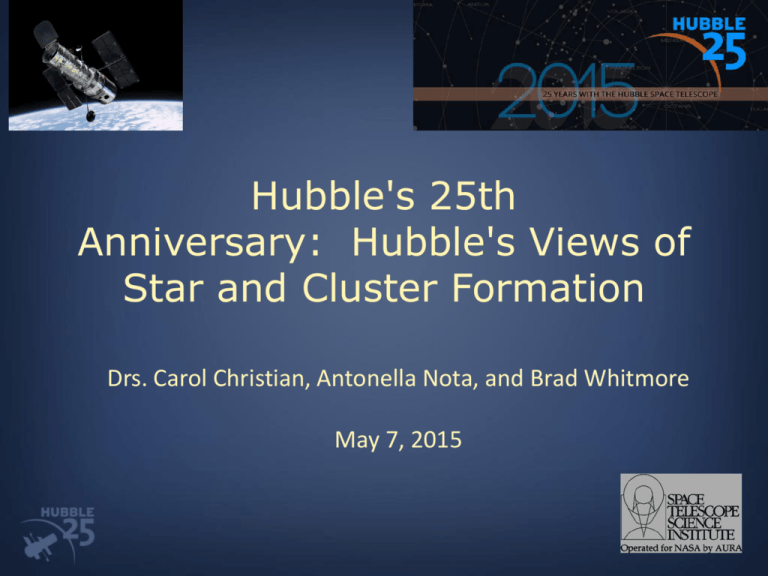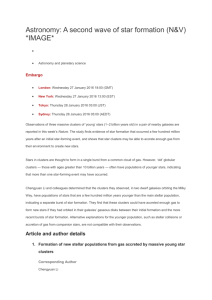PPT Format - HubbleSOURCE
advertisement

Hubble's 25th Anniversary: Hubble's Views of Star and Cluster Formation Drs. Carol Christian, Antonella Nota, and Brad Whitmore May 7, 2015 Stars /Star Clusters Carol Christian • Stars form from gas and dust clouds • The clouds collapse due to gravity • Also the clouds can collide / compress NGC 602 • Stars form in the condensed material • Stars very often form in groups (called star clusters) • Stars vary in mass from much less than the Sun to more than 100 x Sun NGC 3603 2 Star Clusters • As the most massive stars start to shine, they ionize the gas • A cavity is formed with the cluster in it • The gas and dust can be pushed away, collide with other material, and start new formation Tarantula Nebula in Large Magellanic Cloud • Clusters vary in size from a loose grouping (10s of stars) to dense objects (millions of stars) • Depends upon formation process and environment Mayall II in Andromeda Galaxy 3 Westerlund 2 4 5 Westerlund 2 is a very young cluster The way it looks now is the way it formed (has not had time to change) 6 The Westerlund 2 region is abundant in gas and dust 7 We map the dust location We make a “reddening” map We correct the brightness of each and every star using the “reddening map” 8 We measure the brightness and color of all stars in Westerlund 2 We correct for dust absorption We compare with models We derive an age for Westerlund 2 of 0.5 - 2 Myr 9 Hubble's 25th Anniversary: Hubble's View of Star and Cluster Formation Estimating the Ages of Star Clusters in M83: The Southern Pinwheel Galaxy Hubble Science Briefing May 7, 2015 Brad Whitmore 10 Most of the stars that form a galaxy are born in gravitationally bound star clusters. Many of these clusters fall apart, their stars spreading out into the field to form the galaxy as a whole To study the life cycle of star clusters, astronomers need to be able determine their ages. Today I will teach you how to do this too. 11 Slightly older clusters will have enough time to blow a bubble. Here are some very young clusters, with lots of pink light (Hydrogen) around them. 12 Intermediate age clusters have no pink light associated with them, and you can still see the individual stars. Ancient clusters have lost their blue stars so they look like fuzzy, slightly reddish blobs. Old clusters look like a diffuse fuzzy blob. 13 Here is the full sequence: Category 1 Very Young Category 2 Young Small regions of pink light (Hydrogen) around them. Category 3 Intermediate Category 4 Old Intermediate age clusters have no pink light associated with them, and you can still see the individual stars. Slightly older clusters have enough time to blow a bubble. Category 5 Ancient Ancient clusters have lost their blue stars so they look like fuzzy, slightly reddish blobs. Old clusters look like a diffuse fuzzy blob. 14 Astronomers actually use more precise measurements of the colors of clusters to determine their ages, as shown in the plots. Category 1 Very Young Category 2 Young Category 3 Intermediate Category 4 Old Category 5 Ancient 1 Myr 10 Byr Data points in the upper left of these plots are young clusters (1 million years old) while those in the bottom right are old (10 billion years old). You can see that our simple estimates based on their appearance get pretty much the same answers ! 15 Last year at about this time we teamed with ZOONIVERSE to produce a citizen science project to use these simple ideas to measure the ages of star clusters in M83. 16 Let’s walk through some of the pages of the STARDATE: M83 citizen science project and see how it worked. 17 After answering a few questions, the software has determined that this cluster is “Old” (e.g., no pink hydrogen gas – the cluster is diffuse). In this step they also help us measure the size of the clusters. 18 If hydrogen emission is present (pink) we have them measure the size of that as well. The citizen scientists are then invited to explore the image and find other object such as background galaxies. 19 After classifying the cluster, we show them where it is in the galaxy They learn that the young clusters are generally found along the spiral arms. The older clusters are generally found between the arms. 20 Lets try a few together ! #1 #2 #4 #3 #5 #6 #7 21 Lets try a few together ! # 1 (very young) # 2 (young) #4 (old) # 3 (ancient) # 5 (intermediate) # 7 (very young) #6 (intermediate) 22 M31 (Andromeda) Carol Christian Panchromatic Hubble Andromeda Treasury (PHAT) Dalcanton, et al 2012, ApJ, 200, 18. • M31 is nearest large galaxy – companion to our own Milky Way • Survey used mosaic of HST data obtained over several years • Covered 1/3 of M31 in 828 orbits using 6 filters (~40,000 exposures) 23 Andromeda Project: Citizen Science Find the Clusters! • 8 science team members • One month searching the first ~20% of the survey’s imaging • Found ~600 likely star clusters • 4x number previously known in same region Andromeda Project • Too much data for science team alone • Volunteers examine images • Classify objects as clusters (and other) Two Rounds of searching in 2012 and 2013 • Volunteers examine ~20,000 images • ~10,000 unique visitors 24 Andromeda Project: Citizen Science • More than 100,000 image classifications in the first day in December 2012 • Overall classification rate that is greater than one per second! • More than 2 million classifications • 80 individual classifications per image cutout At least 3000 clusters found by volunteers Detailed analysis being conducted by science team Many other ancillary objects found in data also 25 Talk 26 Star / Star Clusters: Why? To understand • Star formation (and planetary system formation) • How clusters form • How parent galaxy environment affects formation • How galaxies form • Clues to early universe galaxies NGC 3344 27






